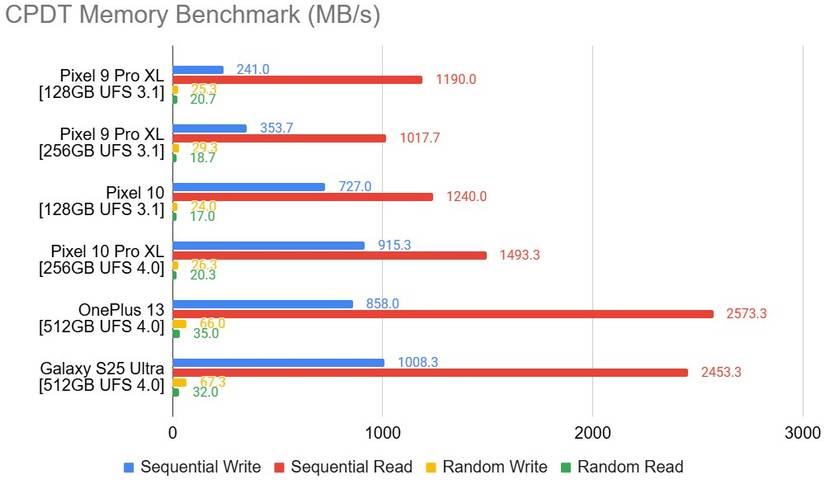It was early 2024. Enthusiasts were a-chatter with discontent that relatively high-performance phones like the OnePlus 12R used UFS 3.1 storage controllers, instead of the newer UFS 4.0 standard. The Pixel 9 lineup faced similar criticism, with critics chastising Google for seemingly hamstringing storage speeds and efficiency.
But one savvy, skeptical Android Police reporter pushed back ever so slightly, pointing out that UFS 4.0 was unlikely to make much real-world difference in either loading apps or increasing battery life. While I’m not always right, Android Authority’s recent comparison of the Pixel 10’s storage to other phones’ proves that this time, I was — to at least some degree.
Improved standards are great
But one number higher doesn’t always mean the world
UFS 4.0 provides up to roughly double the peak read and write speeds of UFS 3.1, as well as up to 46% better efficiency — on paper. Naturally, written specs basically never apply perfectly to real-world performance. Surely, though, such large jumps should make noticeable differences in common use cases, right?
Well, yes, and no. Android Authority’s work showed UFS 4.0 does, in fact, make a difference in some benchmarks, which could translate to a better experience with large files. That might theoretically prove even more true as time marches on, and apps and workloads get bigger. These are seven-year phones, after all.
But the data also highlighted that storage in the relatively meager 128GB Pixel 10 — with UFS 3.1 — is “far faster” than the Pixel 9 Pro. Moving to UFS 4.0 in the 256GB Pixel 10 Pro XL did increase sequential speeds, but not by a mind-blowing amount. What’s more, UFS 4.0 did not appear to make any meaningful improvements to random read or write speeds, so opening small files (which include most apps) won’t be any quicker.
Does anything matter at all anymore?
The UFS standard certainly does, although not all chips adhering to the 4.0 stand will perform identically. Plus, the memory controller is just one piece of the storage puzzle. While Pixel 10s are faster than their predecessors, they’re still noticeably slower to load files than competitors like the Galaxy S25.
Everything from the CPU cores to the memory and the controllers that connect them play a role in how quickly your phone loads what’s stored inside it. Even minute, behind-the-scenes software optimizations can affect storage speed, and as the data shows, sometimes more so than the UFS controller version.
Unfortunately, it’s still prohibitively difficult to precisely measure the storage controller’s specific power consumption. So, you’ll have to take my word on that one: you’re unlikely to notice increased battery life due solely to the new UFS version. But, remember, I’m usually right.
-
Google Pixel 10
- SoC
-
Google Tensor G5
- RAM
-
12GB
- Storage
-
128GB / 256GB
- Battery
-
4970mAh
- Operating System
-
Android 16
- Front camera
-
10.5 MP Dual PD selfie camera
This striking-looking addition to the Pixel line offers a slew of Gemini features, an 5x telephoto lens, and seven years of updates, making this a smartphone that will last you a while.
-
Google Pixel 10 Pro
- SoC
-
Google Tensor G5
- RAM
-
16GB
- Storage
-
128 GB / 256 GB / 512 GB with Zoned UFS / 1 TB with Zoned UFS
- Battery
-
4870mAh
- Operating System
-
Android 16
- Front camera
-
42 MP Dual PD selfie camera
Google’s latest Pro Pixel packs a faster yet efficient Tensor G5 chip, an upgraded ISP, and a brighter display. Plus, an array of new AI features that make it one of the best Android phones to launch in 2025.
-
Google Pixel 10 Pro XL
- SoC
-
Google Tensor G5
- RAM
-
16GB
- Storage
-
128 GB / 256 GB / 512 GB with Zoned UFS / 1 TB with Zoned UFS
- Battery
-
5200mAh
- Operating System
-
Android 16
- Front camera
-
42 MP Dual PD selfie camera
The Pixel 10 Pro XL packs all the same features you’ll find on its less expensive siblings, along with a few exclusive features like a 6.8-inch display and faster charging.


